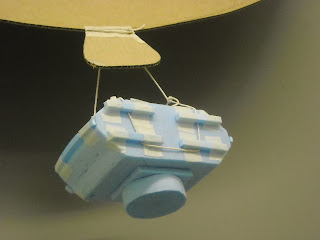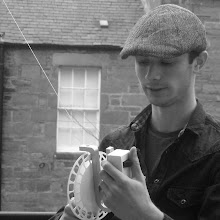The Project
My project started out by looking into domestic photography and how our everyday culture allows us to take photos whenever and wherever. This involved looking at how families store and take photos and the environment that these were viewed in.
I looked at ways to alter, enhance or create a new way of doing this. My idea that I have taken forward still fits with this direction and is a new way to take photos. It explores perspectives of taking photos and the play of light on the digital sensor. This can be classed as extreme or aerial photography.
What is it?
A device capable of taking photos and videos for aerial photography snapshots. This is specifically designed for the attachment to a 3ft balloon giving the device enough lift allowing the view from above to be captured.
But why balloons?? Unlike a kite, they don't require wind conditions to provide the lift. Unlike an RC helicopter it doesn't require propellers or power to lift it. Helium balloons are widely available and can be used almost everywhere.
"Of course, the best thing of all is that any passerby who looks up at the moment your camera takes a picture is sure to be smiling at all those balloons." (photojojo)
Who is it for?
Because I want to create a new photography movement and artistic style of experimental photography, the people that are best associated with this is the lomography community. This group are open to experimenting with photography and are very creative when it comes to taking that unique photo. Because of this my form and styling of my product will be inspired by lomo cameras and the people that use them.
Why am I doing it?
Digital cameras are making photography
'cold,sterile and just not interesting' which is taking away the magic and fun that taking photos had, especially with the polaroid. There was an element of surprise but also disappointment at times by not knowing what the outcome would be. This has now been changed due to the technological advances in photography. This aerial photography device will create a new style of artistic and experimental photography.
How does it work?
-A 3(possibly 5) foot balloon is filled with helium
-Balloon is attached to a camera device
-Camera device is attached to a reel
-Balloon is sent into the air
-Photos/videos are taken via a remote which is built into the reel
-Data is stored on the camera
-Camera is controlled via the reel
-Reeled in to retrieve camera
-Plug into laptop to retrieve photos
Additional Info:
Videos are 30 frames per second and a resolution of 720x480. Photo quality is 1600*1200 pixels. Memory will be classed as internal as an SD card will be inside to store the data but cannot be removed by the user. Data is retrieved through connecting it via usb to a computer/laptop. Videos will be in AVI format while photos will be JPEG.
 The past couple of days I have been playing with different types of lenses. I'm not sure if I will need any of them or if they were used but I felt it was neccessary to test these incase I do decide to use a special lens for my camera.
The past couple of days I have been playing with different types of lenses. I'm not sure if I will need any of them or if they were used but I felt it was neccessary to test these incase I do decide to use a special lens for my camera. The best one that I might possibly use is the fish eye lens. I used the following instructable video to make my own: http://tinyurl.com/ygwx3o5. I really like the idea of using this on my camera but I need to test it out to see what sort of images it can take at the various heights it would be used at.
The best one that I might possibly use is the fish eye lens. I used the following instructable video to make my own: http://tinyurl.com/ygwx3o5. I really like the idea of using this on my camera but I need to test it out to see what sort of images it can take at the various heights it would be used at. I also took the viewing lens from a disposable camera and attached this to my camera. This clears the image up a little more and brings the subject closer. I'm not sure if this is the right road to go down because the images should be reflecting the distance that the camera travels. If I was to use this lens then it would make things closer than they actually are.
I also took the viewing lens from a disposable camera and attached this to my camera. This clears the image up a little more and brings the subject closer. I'm not sure if this is the right road to go down because the images should be reflecting the distance that the camera travels. If I was to use this lens then it would make things closer than they actually are.





 I also took some time to think about the style and pattern on the reel. Also wanting to keep this simple I haven't overly complicated it. My favourite is this one. I have referenced it back to the viewmaster again, this time to the photo cards which it used. I liked how the squares aren't completely angular which helps it to fit onto the reel easily.
I also took some time to think about the style and pattern on the reel. Also wanting to keep this simple I haven't overly complicated it. My favourite is this one. I have referenced it back to the viewmaster again, this time to the photo cards which it used. I liked how the squares aren't completely angular which helps it to fit onto the reel easily. For the handle I have taken inspiration from my mood board of cameras and the idea of using a continuous piece of metal for the handle. Again, I want this to continue the simplicity of the overall product, and kept the rounded curves from the viewmaster styled reel.
For the handle I have taken inspiration from my mood board of cameras and the idea of using a continuous piece of metal for the handle. Again, I want this to continue the simplicity of the overall product, and kept the rounded curves from the viewmaster styled reel.









 This is the first idea that I tried out for the form of the remote. The remote is an important part of my product. It will contain the button which will trigger the camera to take a photo and will be built into the reel which controls the rope. The two interactions will be built into one component.
This is the first idea that I tried out for the form of the remote. The remote is an important part of my product. It will contain the button which will trigger the camera to take a photo and will be built into the reel which controls the rope. The two interactions will be built into one component. Leading on from this I tried a more angular approach but kept the idea of a big red button on the front. Also keeping the grip mouldings, I thought it might be a better idea for these to be on each side of the control. This would be useful for both right and left handed users.
Leading on from this I tried a more angular approach but kept the idea of a big red button on the front. Also keeping the grip mouldings, I thought it might be a better idea for these to be on each side of the control. This would be useful for both right and left handed users.


















 I made a slot on either side which was to hold the rope in place for attaching it to the balloon. The stabalising of this wasn't very good and the camera continuously spinned round which would produce a blurred image.
I made a slot on either side which was to hold the rope in place for attaching it to the balloon. The stabalising of this wasn't very good and the camera continuously spinned round which would produce a blurred image.











